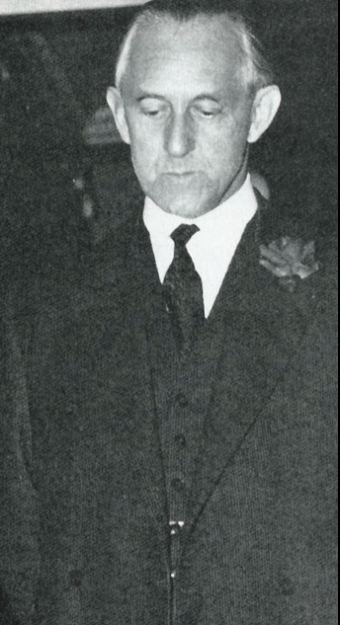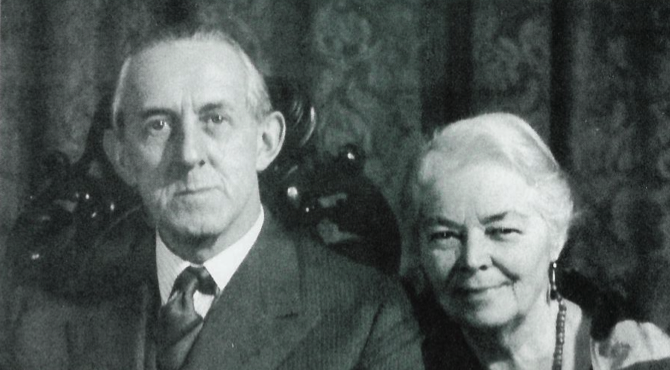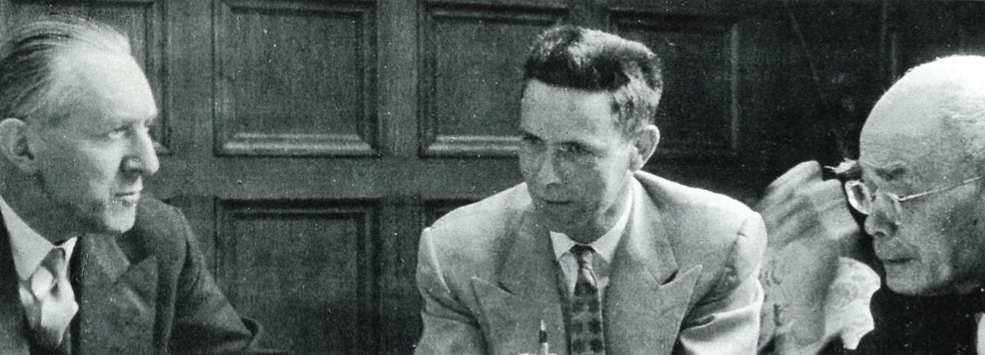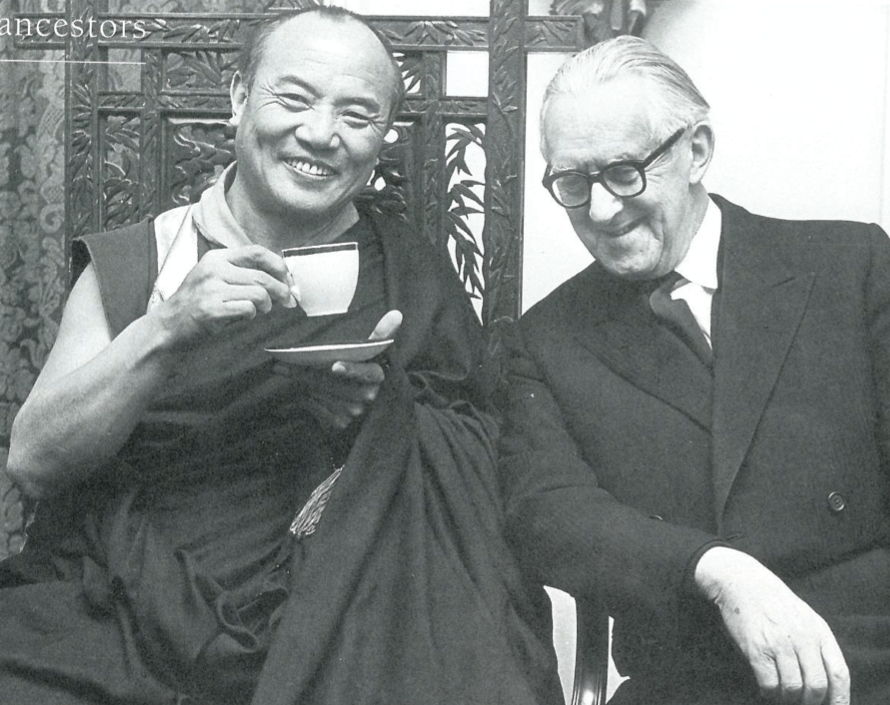 [Humphreys and his wife] ran the Buddhist Lodge from their flat . . . where they had made a hideaway with a bright fire, Persian rugs, incense, golden Buddhas, and a library of magical books which promised me the most arcane secrets of the universe. . . . He is a tall, slender, and limber fellow with big ears, and a clear authoritative voice—always tempered to make it even more so—in which he speaks the best King’s English. . . . He is a man of immense generosity and compassion, and through his taste in Oriental art and literature, radiates an atmosphere of warm mystery.
[Humphreys and his wife] ran the Buddhist Lodge from their flat . . . where they had made a hideaway with a bright fire, Persian rugs, incense, golden Buddhas, and a library of magical books which promised me the most arcane secrets of the universe. . . . He is a tall, slender, and limber fellow with big ears, and a clear authoritative voice—always tempered to make it even more so—in which he speaks the best King’s English. . . . He is a man of immense generosity and compassion, and through his taste in Oriental art and literature, radiates an atmosphere of warm mystery.
—Alan Watts
In 1930, a fifteen-year-old boy named Alan Watts wrote to the Buddhist Lodge in London for information and reached the president, a man with the odd name (especially for a Buddhist) of Christmas Humphreys. Noticing the return address of a prominent boarding school, Humphreys assumed his correspondent was a teacher. He was quite surprised some months later—after a lively exchange of letters—when a fresh-faced schoolboy appeared at his doorstep. But those were the days, as Humphreys explains in his autobiography, Both Sides of the Circle, when attendance at the Lodge was unpredictable. He and his wife might be waiting at their apartment for one of the regular Monday night meetings, and no one would show up.
Humphreys had founded the Buddhist Lodge in 1924 as an offshoot of the London branch of the Theosophical Society influenced by the teachings of Madame H. P. Blavatsky and which met in his apartment on alternate Mondays. At first he had studied Theravada Buddhism because that was the only branch that had been written about in English, and his Lodge had only a single shelf of books. But in 1927, D.T. Suzuki wrote his first series of essays on Zen Buddhism and opened the world of Mahayana Buddhism, which had much more attraction for Humphreys. By the time Watts contacted him, Humphreys was publishing The Buddhist Lodge Monthly Bulletin and writing about Buddhism himself.
Humphreys took the young Watts under his wing and with characteristic magnanimity became his mentor. Watts said later that he “gave me an education which no money could possibly buy” and “put me on my whole way of life.” Humphreys introduced him to the writing of Suzuki and, some years later, to the man himself. There are various photos of the three men through the years: the cadaverous and often melancholy-looking Suzuki, the lean, angular Alan Watts, and beside them, the hearty Englishman, Humphreys. It was these three men as much as any who introduced Buddhism to the English-speaking world in the 1940s and 50s, kicking off a wave of interest that has yet to end.

Of the three, Humphreys—at least in North America—is perhaps the least known. Watts expatriated to the United States and was associated with the Beats and with the boozy, drug-taking, sexy sixties, and Suzuki was a revered scholar who took the wordless transmission of Zen and spun it into convoluted and difficult sentences in any number of essays. Humphreys, on the other hand, was an apparently conventional Englishman who stayed married to one woman, had a distinguished career in criminal law, and finally wound up as a judge at the Old Bailey. He hardly fits our image of a new Western Buddhist.
Yet in some ways his was the most remarkable career of the three. When he founded the Buddhist Lodge, later known as the Buddhist Society, he was just twenty-three and acted as its president for nearly sixty years, until his death in 1983. The Buddhist Society exists to this day, offering ongoing classes, a summer school, an extensive library of tapes and books, and a website. Its newsletter, which had circulated transcripts of the Monday night lectures, evolved into the distinguished Buddhist journal The Middle Way, still published today. Humphreys himself, though he gives little indication in his autobiography of where he found the time, composed some twenty-five books, fifteen of which concern Buddhism and spiritual practice.
If it is true that Humphreys’s Buddhism is a combination of Blavatsky and, as Watts said, “crypto-Protestantism,” it is also true that Humphreys made an important early attempt to take the voluminous history of Buddhist teachings and put them in an accessible and coherent form in English. There may be better sources of this information today, but there weren’t then, and Humphreys is an important transitional figure. He mentored the English-speaking world as he had the young Alan Watts, leaving us to separate the wheat from the chaff. In his own autobiography, Watts has left behind one of the best descriptions of the man and the atmosphere that surrounded him.
In fact, Humphreys was the kind of energetic and essentially optimistic person, even as a child, who went through the British educational system described with such horror by writers like George Orwell—and found it absolutely delightful. Born in 1901, he had the advantage of coming from a well-off family; his father preceded him in his criminal law career and was also a distinguished judge. Humphreys describes his childhood as positively idyllic, with nothing more fun than the family’s tennis lawn parties on Sunday afternoons. He was also a “confirmed and deeply practicing Christian” as a youth.

Yet in the lives of all men born in his day, the First World War loomed as a dark cloud at the end of their schooling. Everyone expected to serve, and Humphreys certainly would have if the war hadn’t ended just before he came of age. His older brother wasn’t as lucky: Richard Humphreys lost his life while stationed in Belgium. His death was the first real shock in Humphreys’s life.
The wound went much deeper than a schoolboy’s learning of a beloved brother’s death. . . . From that hour I began a journey and it has not ended yet, a search for the purpose of the universe, assuming it has one, and the nature of the process by which it came into being.
One wonders if he wouldn’t have found his way to that search in any case. He seems to have been drawn all his life to what would later be called the counterculture, alternative medicine, ESP, and spirituality in general; he even belonged to a society devoted to proving that Shakespeare didn’t write the plays. He was an enthusiast and could be deeply and immediately impressed by significant encounters; in his autobiography he speaks of the “six great men” he met in his life and of the most influential books.
One of those was the first book he read on Buddhism, Buddha and the Gospel of Buddhism, by Ananda Coomaraswamy. “If that is Buddhism,” he said when he had finished, “then whatever else I am I am a Buddhist.” He read another such book, The Secret Doctrine, by Madame Blavatsky, while studying at Cambridge, and—if we can judge by his reaction—it was even more influential. Finally, he had read something that explained his brother’s death.
For me in 1920 it made sense of the universe with its ‘coming to be, ceasing to be,’ in enormous cycles of the illusion of time, cycles of life-forms too small to be seen and too large to be cognised. It gave me a new sense of life as one and inseverable and of every thing alive and conscious.
Madame Blavatsky, though she did at one point take the precepts in Sri Lanka, was not really a Buddhist, but had a larger—and somewhat vaguer—religious vision. She believed that the vital core of all religions was a part of a “secret doctrine,” which was taught by Adepts who lived around the globe and which had been taught to her by two Tibetans with whom she communicated telepathically. She was known for demonstrations of spiritualist phenomena and for her psychic powers. Though many people considered her a fraud, Madame Blavatsky was important in reviving Buddhism in the East—specifically Sri Lanka—and bringing it to the West.
Watts, under Humphreys’s tutelage, read The Secret Doctrine at roughly the same age that Humphreys had, but didn’t swallow it in the same way. He would later say that Madame Blavatsky had “only the most fragmentary knowledge of Tibetan Buddhism, but she was a masterly creator of metaphysical and occult science fiction.” If there is a major flaw in Humphreys’s writing about Buddhism, it is the influence of Theosophy. He sometimes makes the Buddha sound like one of Madame Blavatsky’s Adepts:
Unable to teach all that had been imparted to him—owing to his pledges—though he taught a philosophy built upon the groundwork of the true esoteric knowledge, the Buddha gave to the world its outward material body and kept its soul for his Elect. This ‘soul,’ the Doctrine of the Heart, is to be found in fragments, usually mutilated, in all the Scriptures of the world. It is the ancient Wisdom to which all Arhats, Rishis, and other perfect men achieve. It has a thousand forms, yet is eternally one.

Since the Buddhist Lodge had originally been founded as an offshoot of the Theosophical Society of London, Humphreys wisely decided, at a time when there wasn’t enormous interest in Buddhism, to keep the society nonsectarian. Through the years he hosted a wide variety of visitors and speakers, including—in addition to Suzuki—T’ai-hsu, patriarch of Chinese Buddhism; G.P. Malalasekera, Buddhist scholar and diplomat of Ceylon; the Burmese Bhikkhu U Thittila; and—from Tibetan lineages—Dudjom Rinpoche and the Dalai Lama. By the late twenties he had left the Theosophical Society—“finding that the leech-like minor movements about it stifled the teaching it was founded to proclaim”—and devoted himself to what he had by now renamed the Buddhist Society.
Humphreys was never narrowly Buddhist, but was interested in all spiritual teaching. The first of the six great men he cited in his autobiography, for instance, was not a religious teacher at all, but a Russian “explorer, geologist, artist, herbalist” named Nicholas Roerich. Another was the religious teacher Meher Baba, who “literally radiated love. It was a physical sensation of warmth and I have never experienced anything like it.”
He nevertheless had biases and didn’t try to hide them. In his central work, Buddhism, published in 1951, he gives five full chapters to Theravada teachings, but also states his conviction that Mahayana teachings were a distinct advance over them. Nor could he sufficiently praise Suzuki, the man who did the most to explain Mahayana teachings to him: “the greatest, in the sense of the most spiritually developed, man that I have known and dared to call my friend.”
Humphreys gave perhaps his most comprehensive overview of Buddhism in this book, including a short life of the Buddha and an extensive history of Buddhist thought. He had a Theosophist’s way of breaking into exalted rhetoric, but sometimes tempered it with a British barrister’s measured tones. Early in the book, for instance, he describes what he thinks the Buddha’s teaching really was:
He dealt with life, not with the changing forms of it, and life can never be locked away in glorious phrases. The Buddha’s teaching was a mode of living, a method of approach to life itself.
He also does a fine job of explaining how the Mahayanists, in explaining nirvana, come full circle.
Nirvana . . . is not the goal of escapism, a refuge from the turning Wheel; it is the Wheel, and he who realizes himself in this discovery makes his daily life divine. For him all things are Suchness, and he sees but the Suchness of things. His Citta, or inmost heart and mind, is one with the Universe; he is Mind-Only.
Elsewhere, however, his Buddhism sounds like pure Theosophy:
All forms of life are sharing the same eternal Essence of Life. More, all is alive, and there is no death, save of the temporary form. The whole universe is one, and when the Manifest returns into the bosom of the Unmanifest all things will find their unity. . . .The Universe is a mode of law, but love is the fulfilling of the law, for love is the cohesive element in all illusion-separated things, and in the end the parts will know themselves as one.
By this time, Humphreys had become an important figure not just in Western Buddhism but in world Buddhism. He spent an enormous amount of time in his later years visiting Buddhist sites and meeting Buddhist teachers in Japan, Nepal, India, and Thailand. He attended multiple conferences of the World Fellowship of Buddhism and was one of those called on for counsel when the Dalai Lama fled Tibet, working tirelessly to improve his lot and that of other exiled Tibetans.
In 1975, Puck, Humphreys’s beloved wife and fellow worker, who was ten years older, preceded him in death. He retired from his judgeship soon after that, but continued his work with the Buddhist Society until his very last day, dying of a sudden heart attack as he was sitting down to a period of zazen with a group of friends. He was eighty-two.
With his lifelong study of Buddhism and career in the law, Humphreys managed to be a man of contemplation and a man of action at once. What ultimately appealed to him about Buddhism was that it put the responsibility on the individual; the supposed last words of the Buddha that he kept coming back to were that we must work out our own liberation, with diligence. Somehow, for Humphreys, his salvation was tied up with his public life, his determination to keep concentrating—as he loved to say—on the Next-Thing-To-Be-Done.
But he understood that the point of it all wasn’t some list of accomplishments. In his enormously accomplished life, both as lawyer and secular Buddhist teacher, he was remarkably matter-of-fact and modest about all he had done, as if it were nothing, which—from a Buddhist point of view—it was. At the end of a chapter on Buddhist art in Buddhism, Humphreys revealed:
The Buddhist’s purpose in life is to raise the quality of living as distinct from the standard of living, to eliminate the self which hides the light of his own Enlightenment rather than to improve the comfort of his worldly life. His proudest creation is therefore his own character, and if the average Buddhist is far from a perfect exemplar of his Master’s Teaching, history has shown that the fruits of Buddhism have been not only great art and culture, but, what is greater still, great [people].